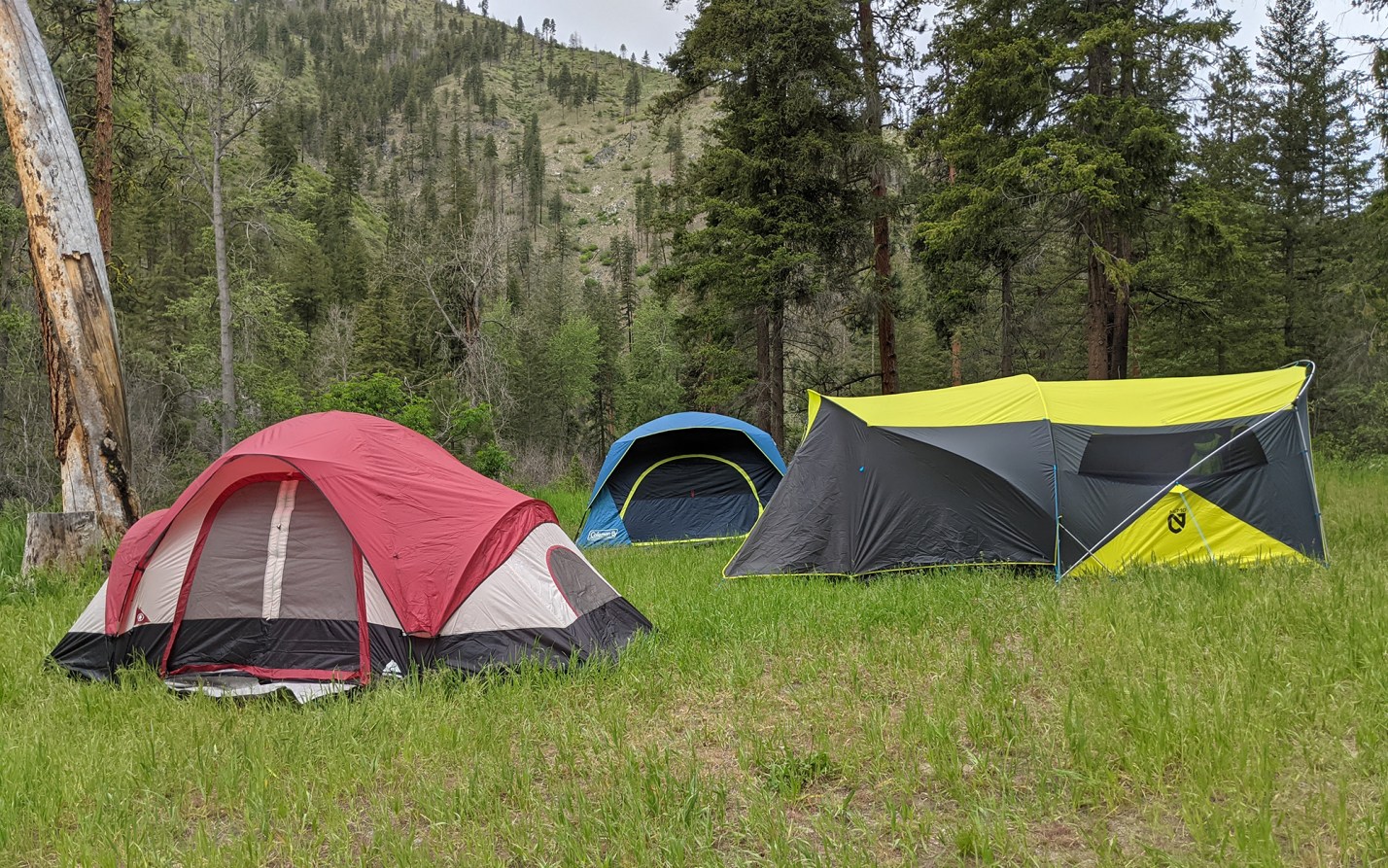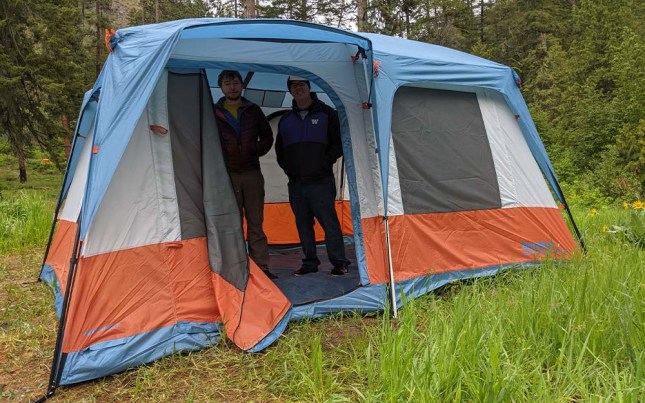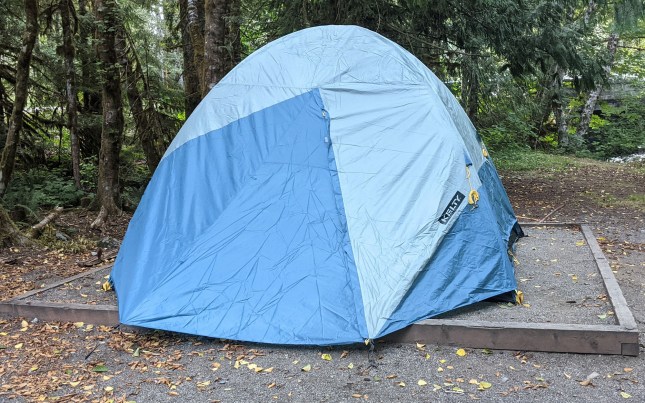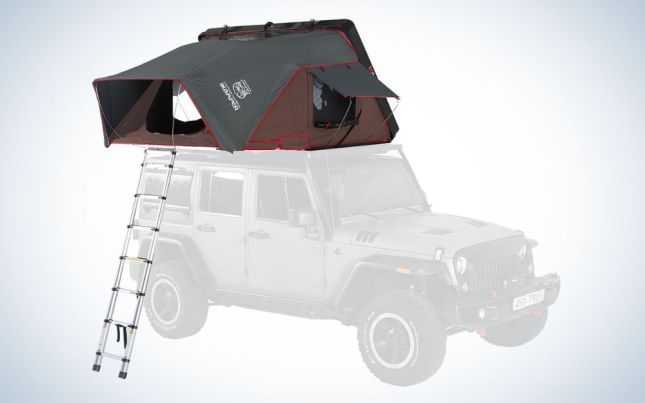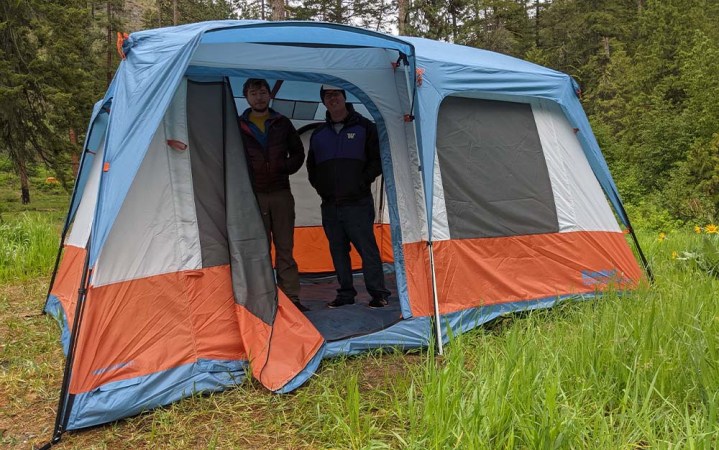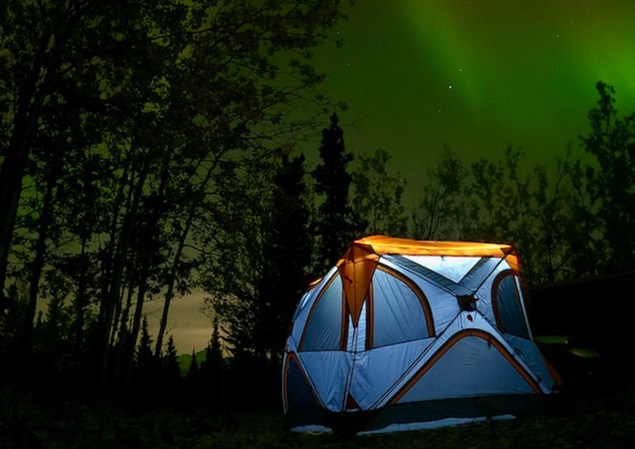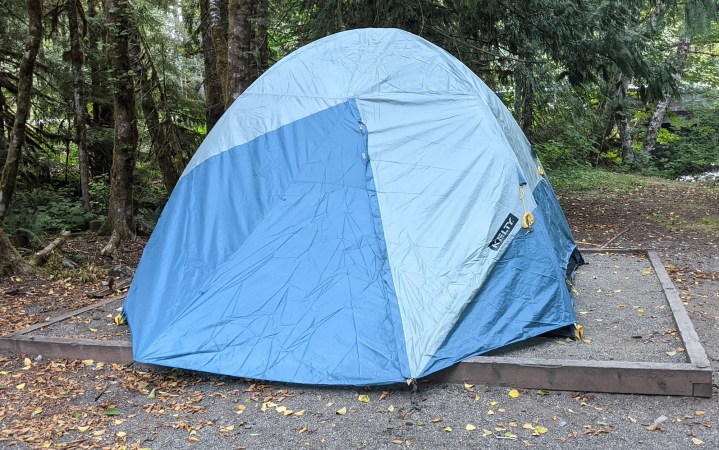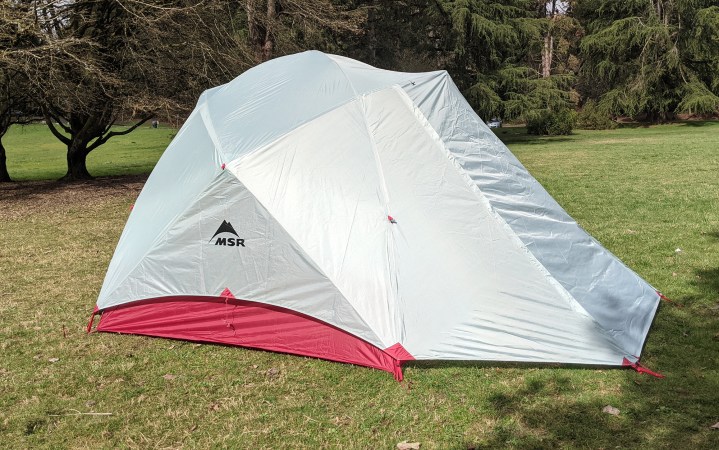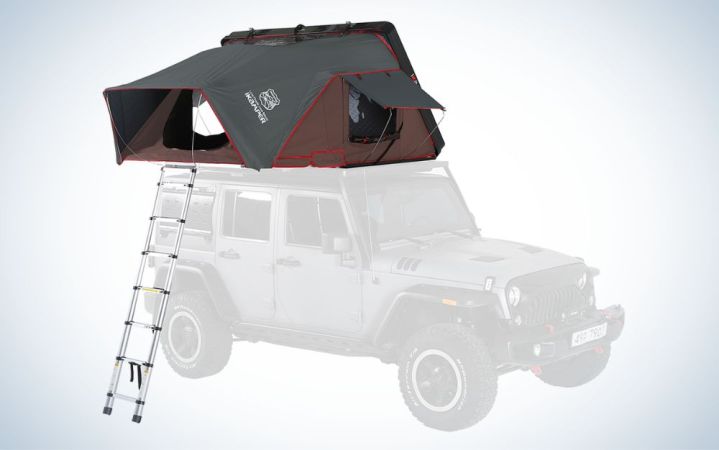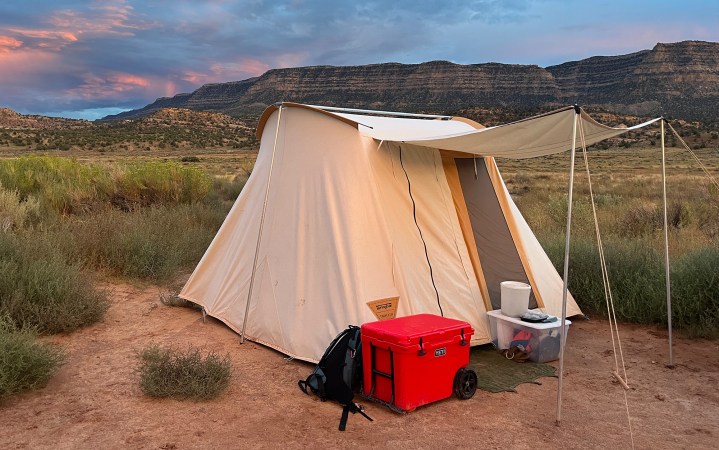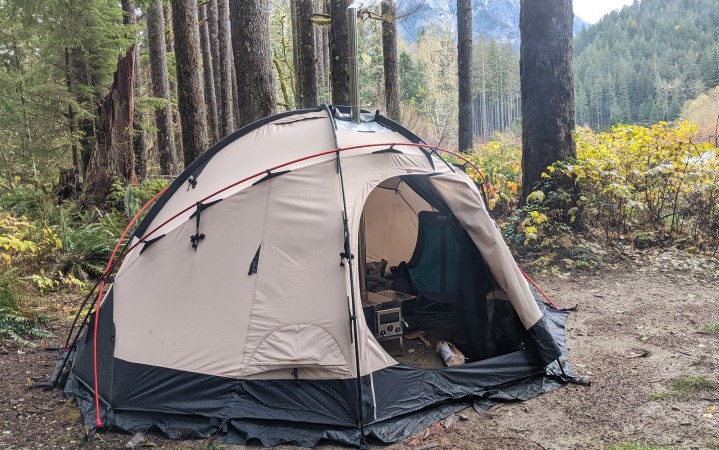We may earn revenue from the products available on this page and participate in affiliate programs. Learn More ›
The right car camping tent can make or break your time away in the great outdoors. Outdoor Life editors and contributors have been testing tents while camping and backpacking for years, from top brands like Eureka, Coleman, and MSR, as well as lesser known options. Over innumerable nights in different tents, we’ve experienced 25 mile per hour gusts and lightning storms; sunshine and snow. Here are our picks for the best car camping tents.
- Best Overall: Eureka Copper Canyon
- Best Instant: Magellan Outdoors Pro SwiftRise
- Best Value: Kelty Discovery Element
- Smallest Packed Size: MSR Habiscape
- Best Rooftop Tent: iKamper Skycamp 2.0
- Best Canvas: Springbar Traveler
- Best Hot Tent: Nortent Gamme
How We Tested the Best Car Camping Tents
There are hundreds of car camping tents on the market, from budget Amazon brands to pricey palaces built by the same American companies that design mountaineering tents for Everest. For Outdoor Life’s tests, we focused on comparing like against like across a range of conditions. I tested the best 8-person tents and the best 6-person tents in conditions just stormy enough to make me question whether car camping with the family was a good idea.
Contributor Justin La Vigne let multiple inches of snow fall on the best instant tents to choose his top pick in that category. Assistant editor Ashley Thess and I teamed up to assess the best canvas tents and the best hot tents. Contributor Alex Murphy found out first hand how well the best rooftop tents handle heavy winds while camping with his family in northern Colorado. And we’re still testing tents to see which ones have what it takes to protect our families from the elements.
Best Car Camping Tents: Reviews & Recommendations
Best Overall: Eureka Copper Canyon
Key Features
- Available as a 4-person, 6-person, and 8-person model
- Cost: $270 to $500
- Peak Height: 84 inches (all models)
- I tested the 8-person tent in high winds and light rain on the eastern slopes of the Cascade Range
- Warranty: Limited lifetime
- Offers in-house repairs
Pros
- Great interior space
- More weather-resistant than you’d guess looking at it
- Affordably priced
Cons
- More complicated setup that typically requires two adults
At first glance, the Eureka Copper Canyon doesn’t look like a tent that can withstand major gusts or even keep rain from seeping inside your tent. But that’s why hands-on testing is so important: The best way to find out if a tent can hold its own with the likes of Nemo and Big Agnes is to set them up side by side in a river canyon in eastern Washington and see how they fare as the weather turns.
Not only did this tent pass with flying colors, but it managed all that while providing superior interior living space. The ceiling in this tent is one of the highest I’ve tested, and it’s boxier shape (reminiscent of cabin-style tents) made it easier for the family of four (three humans and one pup) who tested it to navigate different bedtimes. The high ceilings do mean that you’ll need an extra set of hands to set up this tent if you are on the shorter side (getting the rainfly on by myself proved impossible for this 5-foot-5 tester). While everyone (including myself) was concerned that the windows were not sufficiently secured against rain seeping in, the test proved us wrong: This tent sufferend no leaks, something that couldn’t be said about other (more expensive) options I considered.
Read Next: The Best 8-Person Tents
But my favorite part about this tent is that it’s a relatively affordable option that’s also backed by a great warranty. If you’re looking for your family’s homebase for this coming camping season and beyond, start your search with the Eureka Copper Canyon.
Best Instant: Magellan Outdoors Pro SwiftRise
Key Features
- Available in a 4-person model only
- Cost: $200
- Peak Height: 77 inches
- OL contributor Justin La Vigne tested this tent in high winds and even snow over two months near Denali in Alaska
- Warranty: One year
- Does not offer in-house repairs
Pros
- Very durable
- Spacious interior
- Easy setup
- Affordable
Cons
- Very limited warranty
- Large packed size
- Heavy
Instant tents have been seeing a resurgence, and for good reason. While older models were easy to set up, but a nightmare to take down, newer designs have cracked the code on how to make the user experience more intuitive, especially for first-time tent users. This gear reviewer’s feeling is that, with practice, traditional dome tents go up plenty fast (and offer a wider range of models to choose from), casual campers who are trying to reduce complexity in their setup should give this new generation a look. While the extremely limited warranty on the Magellan Outdoors ProSwift Rise gives me pause, Alaska OL contributor Justin La Vigne really put this one through its paces, and found its durability to be first rate.
Read his review here: Best Instant Tents
Best Value: Kelty Discovery Element
Key Features
- Available as a 4-person and 6-person model
- Cost: $130 to $200
- Peak Height: 61 inches (4-person), 77 inches (6-person)
- I tested the 6-person tent during a storm on the western slopes of the Cascade Range
- Warranty: Limited lifetime warranty
- Offers in-house repairs
Pros
- Easy setup
- Very affordable
Cons
- Less usable headroom than in other tents I’ve tested
Camping gear can get pretty expensive when you add it all up, which accounts for a lot of the enduring popularity of budget brands like Ozark Trail and Coleman. My favorite low-cost car camping tent brand from testing is Kelty, particularly their Discovery Element tent. It’s affordable and a snap to set up with an intuitive, color-coded design. My test of the best 6-person tents saw an epic rainstorm, and the Kelty Discovery Element was completely dry inside on the other side of it. If you’re looking for a tent that will last for years but aren’t fussy about the aesthetics (this one has noticeably worse headroom than my best overall pick, and only one door), then this is a great choice.
Smallest Packed Size: MSR Habiscape
Key Features
- Available as a 4-person and 6-person model
- Cost: $500 to $600
- Peak Height: 73 inches (4-person), 77 inches (6-person)
- I tested on multiple family outings in Washington State that featured rainstorms
- Warranty: Three years
- Offers in-house repairs
Pros
- Easy to pack away again
- Great interior space
- Pass-through pockets are a great detail
Cons
- Somewhat more fragile than other tents made with steel (as opposed to fiberglass) poles
- On the pricey side
The MSR Habiscape is my go-to when packing for family camping trips. It’s roomy inside, with great headspace. It has something called a “pass-through” pocket on each side, which allows you to put something into the tent without going through the hassle of opening up the double-doors (gamechanger). But the real deciding factor is its size: This tent is so petite that I sometimes save it to pack last, cramming it into whatever gap there is between the cooler and the camping box.
Just as with the best ultralight tents, though, there are some tradeoffs for that small packed size. The most obvious one is price, but there is a second issue: durability. Most quality car camping tents have big burly stainless steel poles that are difficult to manage but virtually impossible to break. Budget options (including the Kelty pick above) have fiberglass poles that bend easily but are also prone to breaking if pushed too far. The poles on the MSR Habiscape split the difference. The svelte stainless steel poles have a lot of pliability to them, but can break (as I learned during my test of the best 6-person tents). This is perhaps not the right tent for first-time campers, but if you’re experienced with the care required for standard backpacking tents, the space savings in your adventure rig are a real gamechanger.
Best Rooftop Tent: iKamper Skycamp 2.0
Key Features
- Available as a 4-person model only
- Cost: $3,900
- Peak Height: 45 inches
- OL contributor Alex Murphy tested this tent on multiple outings in Colorado that featured high winds
- Warranty: Two years
- Does not offer in-house repairs
Pros
- No need to worry about finding a flat campsite
- Universal mounting system allows it to fit on most vehicles
- King size memory polyfoam mattress
- Easy one minute set-up time
Cons
- Very expensive, with a limited warranty
- No options for larger families
There’s no denying it: Rooftop tents just look cool. Why mess around with sleeping on the ground, just a few inches of foam and a thin nylon floor between you and the elements, when you get up high in a tent on top of your car? You also don’t have to select a perfectly soft and flat site to erect your tent, just a level place to park the car, and a whole new world of dispersed camping just opened up to you.
The biggest drawback is price. Rooftop tents are many orders of magnitude more expensive than traditional tents. So which one is worth the money? OL contributor Alex Murphy tried out four different brands and came convinced that the best option out there was the iKamper Skycamp 2.0.
Read Alex’s full review here: Best Rooftop Tents
Best Canvas: Springbar Traveler
Key Features
- Available as a 6-person model only
- Cost: $1,300
- Peak Height: 77 inches
- OL Assistant Editor Ashley Thess tested this tent on multiple outings in Utah and Colorado that featured high winds, downpours, and hail
- Warranty: Satisfaction guaranteed
- Offers in-house repairs
Pros
- Best-in-class combination of warranty and repair options
- Durable
- One-person setup
- Made in the USA
Cons
- Expensive
- Heavy
- Must be staked into the ground
If you’re wondering if a canvas tent is worth the extra weight and expense, assistant editor Ashley Thess has two words for you: Hell yes. Her review of the Springbar Traveler might be better termed a love letter, with everything from vivid descriptions of the different extreme weather she experienced to her tour of the Springbar workshop where they make and repair the tents (that “Satisfaction Guaranteed” claim is legit; she saw them repairing tents upwards of 40 years old). In our day and age of knockoff brands and overseas production, it’s refreshing to test a product that truly is buy it for life.
Read Ashley’s review here: Best Canvas Tents
Best Hot Tent: Nortent Gamme
Key Features
- Available as a 4-person, 6-person, and 8-person model
- Cost: $1,120 to $1,640 (does not include stove)
- Peak Height: 63 inches (4-person), 73 inches (6-person), 85 inches (8-person)
- I tested this tent in the Cascade Range foothills during a November downpour
- Warranty: Five years
- Offers in-house repairs
Pros
- Opens up the world of shoulder season and winter camping
- Excellent, quality craftsmanship
- Easier to use than you’re expecting
Cons
- This ultra-efficient stove takes some care to get the smoke flowing the right way when you first light it up
- Not the best choice for families
For the uninitiated, hot tents are tents designed to accommodate wood-burning stoves. That’s right, you are starting a fire in the tent, and it is a lot of fun. Hot tents take one of those rainy, dreary days in the woods where you feel trapped in your tent and turn it into the coziest thing imaginable. I’ve tested a few of these at this point, but the one I’m the most excited about is the Nortent Gamme. The 6-person version of this tent was fairly easy to set up, as was the stove, which was great since I forgot to download the directions on my testing trip and was out of cell range. The domed tent fit two adults, including a double air mattress and a couple of chairs for lounging in comfortably. But what really won me over was the stove.
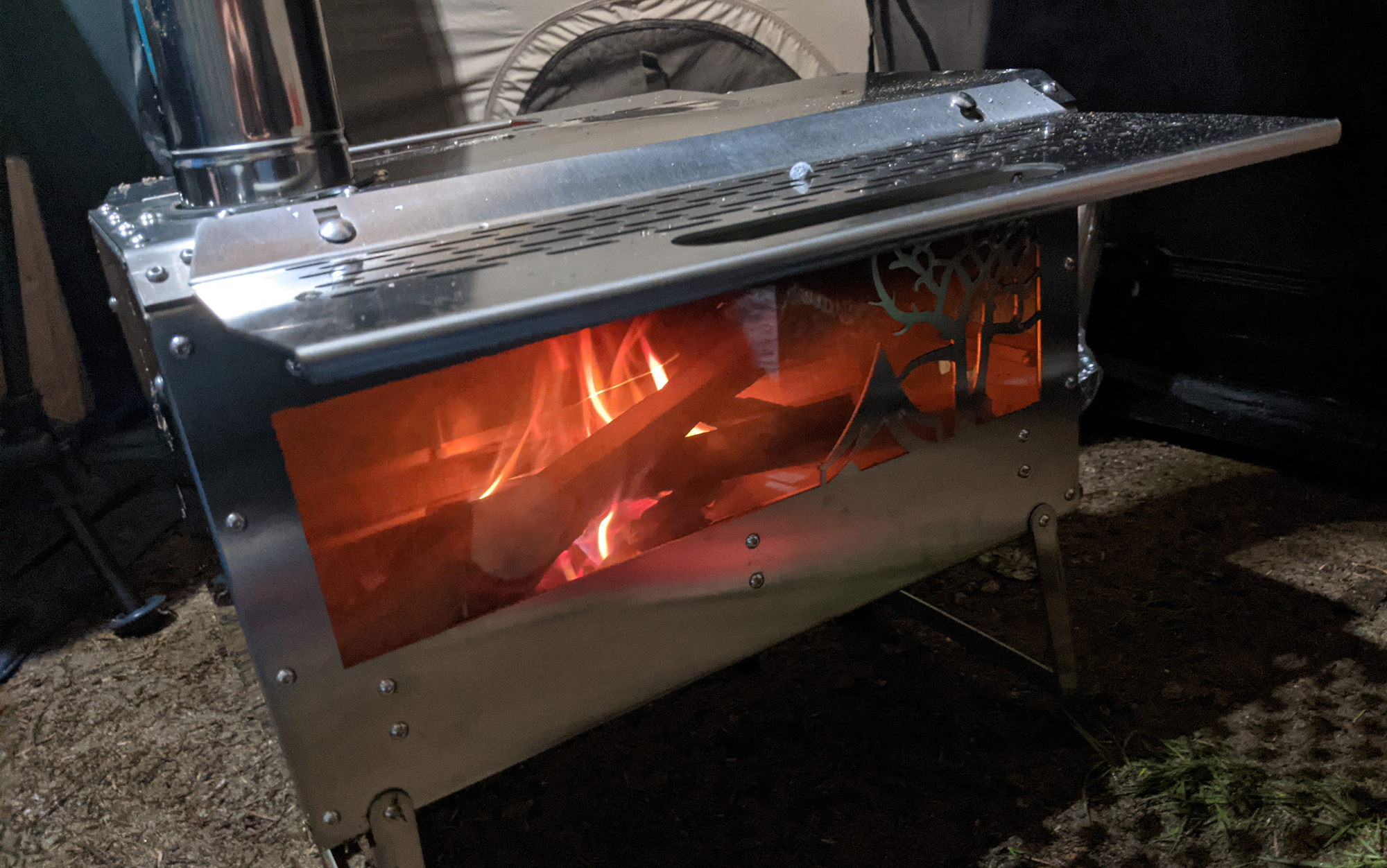
Laura Lancaster
Not only was it beautiful to look at, with glass windows on three sides for admiring the fire, it was also surprisingly efficient, needing only a small bundle of kindling to keep going through the evening hours, playing card games and drinking cocoa. I’m hoping to get it out to the coast next, and set it up with a nice ocean view.
Read Next: Best Hot Tents
If you’re searching for a quality tent to see you and your family through a few long weekends over the summer, a hot tent is not what you need. But when summer ends, and you’re waiting out the doldrums of shoulder season for ski season to start, you’re going to remember that Outdoor Life writer waxing lyrical about how much fun camping in a PNW rain/snow mix was with a Nortent.
The Rest of the Field
I’ve tested numerous car camping tents from Big Agnes (Big House and Bunk House) and Nemo (Aurora), well-known names in the backpacking world, and have been routinely impressed by the quality of their construction. While these tents are pricier than my best overall and best value picks, they are great options for any family. Look for them on sale. While I have not tested any REI tents for several years, I would include them in this category as well, despite an unfortunately limited warranty (one year).
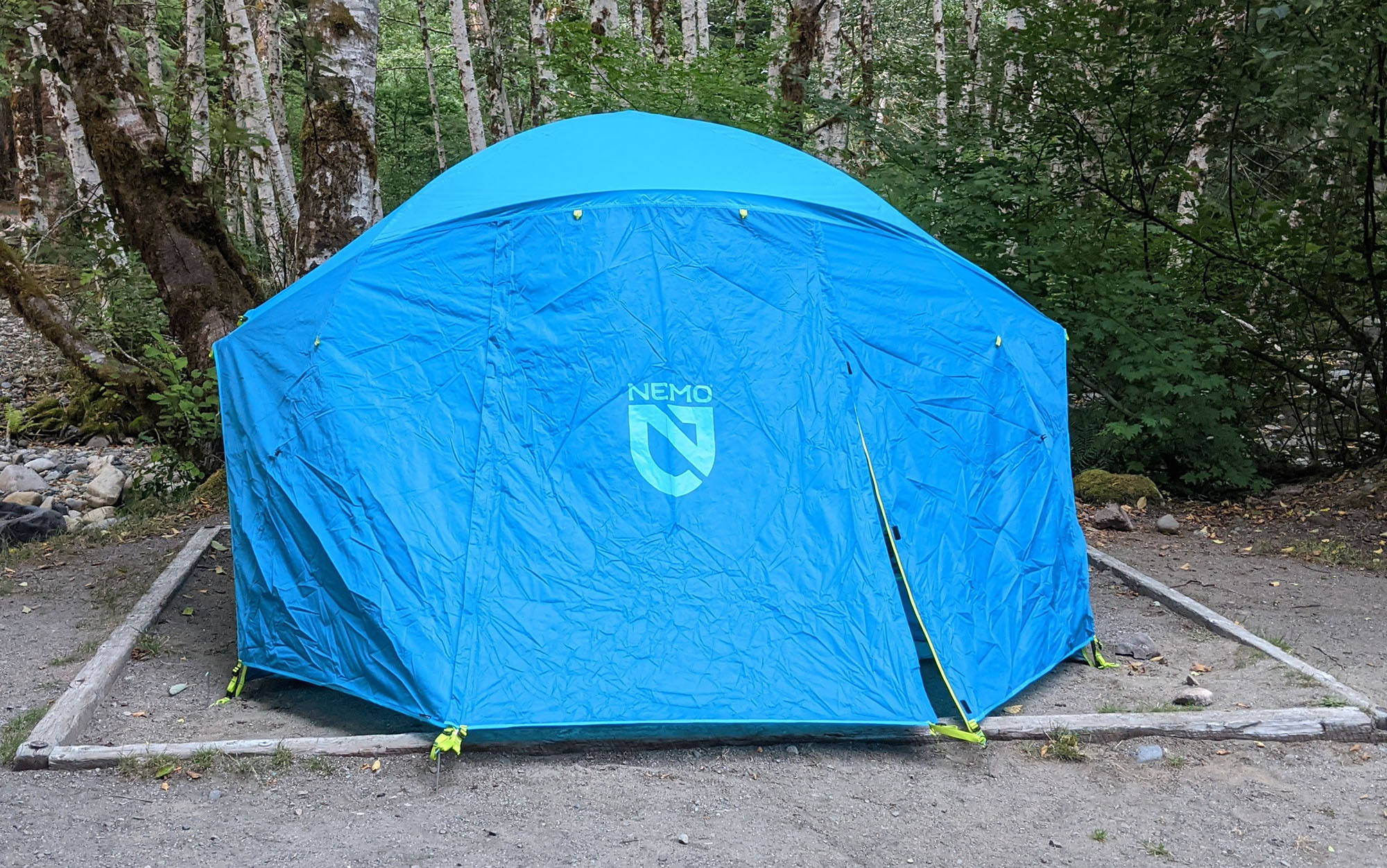
Laura Lancaster
If you’re on a budget, Coleman tents are an option to consider. In my experience, they are more difficult to set up than my best value brand, Kelty, for only minor savings. But they are otherwise fairly similar in terms of construction and warranty.
I’ve had mixed experience with Decathlon’s tents, partially stemming from the differences between European and American tent manufacturing. If you’re accustomed to the crisscrossing pole setup of most U.S.-based tent manufacturers, you may also find yourself scratching your head at some of their designs. However, they do offer pretty good products at reasonable prices.
The one tent I tested from Wenzel ended up with a snapped pole due to flimsy materials and an overly ambitious design. I’d also steer clear of the Walmart brand Ozark Trail, whose tents’ numerous fail points (unsealed seams along the floor; insufficient rainfly coverage) could allow rain to drip inside of your tent.
Inflatable tents seem to be making a comeback, and I tested a three-person version from Heimplanet to mixed results. While it looked very cool and was fairly easy to set up, the packed size of the tent plus the pump didn’t actually result in any space savings.
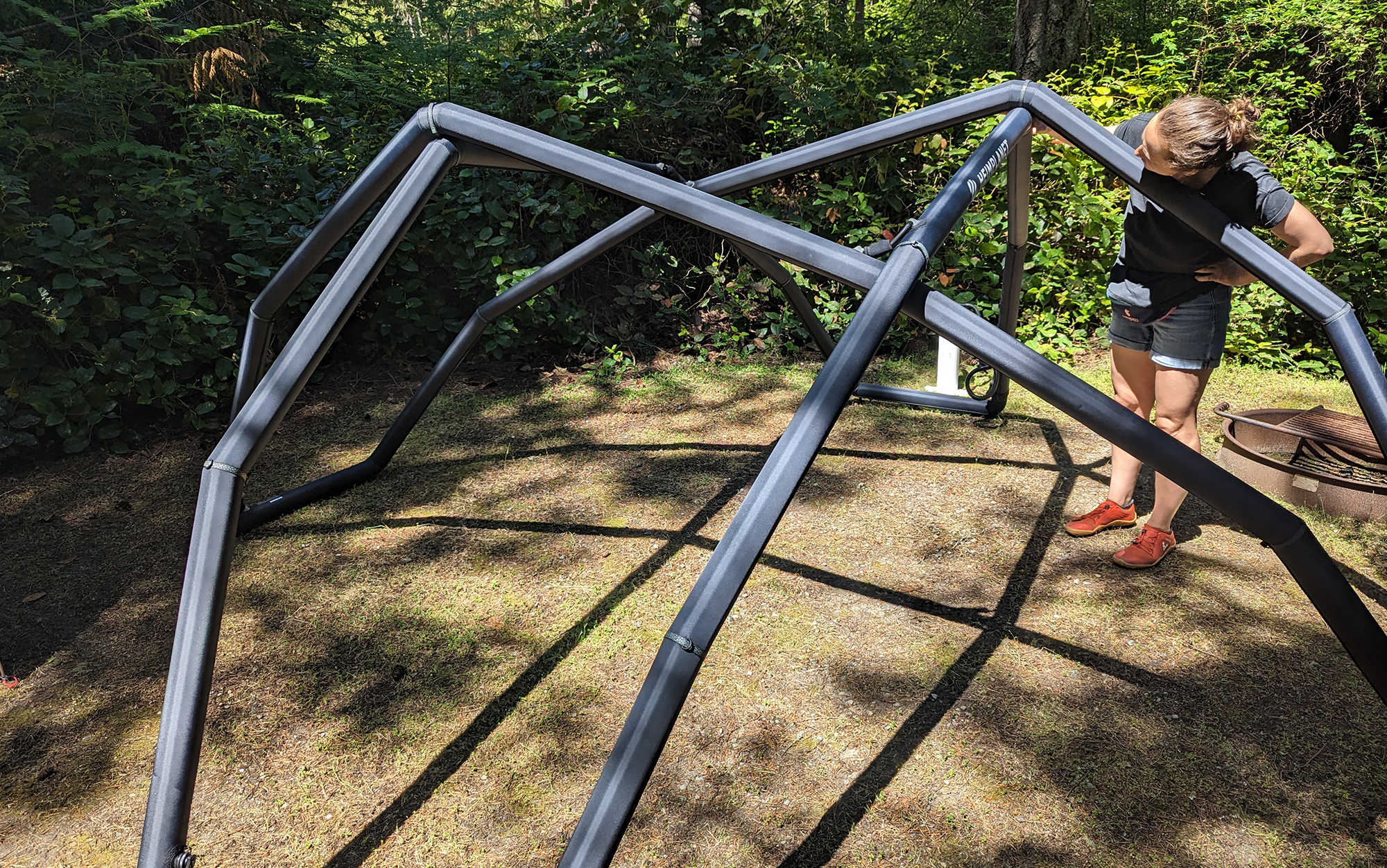
Laura Lancaster
I also didn’t find it overall easier to use than a classic crisscrossing pole tent setup, despite it’s significantly higher price tag. If you’ve been burned in the past by difficult pole setups (and they are certainly out there), then you could consider, but a word to the wise: Even a small hole or tear in the supporting beams of these tents will compromise its structure, and good luck finding it.
How to Choose the Best Car Camping Tent
Size
The size of car camping tents is typically denoted by the number of people that could sleep inside it. Keep in mind that this doesn’t mean comfortably; it’s the number of people that would fit if you crammed them all in like sardines. If you’re purchasing a car camping tent for the first time, plan to look for a tent that fits 50 percent more people than are in your family. So if you’re a family of two, look for a three-person tent. A family of three can get away with a four-person tent, but might be happier in a six-person tent. A family of five (two adults, two kids, and a pup) should go for an 8-person tent.
Packed Size
The size of a tent can vary considerably, impacting how much other gear you may be able to fit in your adventure rig. The most space-effective designs are typically the crisscrossing poles and nylon models most associated with car camping. Pop-up or instant tents usually take up twice the space of a regular tent. Canvas tents are even worse, typically taking up three times or more the space of a standard nylon tent. Rooftop tents prevent you from putting much of anything else up there.
Cost
The best car camping tents can range in price from less than $100 to multiple thousands. However, in this case you get what you pay for.
Warranty
I’ve tested tents that haven’t survived their first outing outdoors and others that I’m confident I could pass down to my kid. The warranty is one of the best indicators as to which type of product you are looking at. The best tents will have lifetime warranties, as opposed to limited lifetime warranties, and offer in-house repairs. “Satisfaction guaranteed” is also sometimes used in place of a lifetime warranty. Unfortunately, many companies have discontinued some of the more generous warranties in recent years.
Ease of Setup
In my experience, most 6-person tents and smaller can be easily put up by a single adult. It’s once you get to the 8-person or larger tents that things get tricky, often requiring multiple adults. Consider how many adults you’ll have to spare (young children can make this a tricky equation) when choosing a tent for the first time.
FAQs
The best tent brands are those that have decades of experience in the outdoors, be it camping or backpacking, and are attuned to how the engineering details of a tent make it more or less adaptable to different climates or weather conditions. Most, although not all, also use higher quality material that will typically last longer than lower grade nylon or polyester. Finally, a high-quality tent will have a long warranty period—if a manufacturer isn’t willing to guarantee their tent for more than a season, it probably isn’t any good.
The biggest factor in camping comfort is warmth. If you’re cold, you’re going to be uncomfortable. Purchasing a high quality sleeping pad will not only cushion you against the ground, but it will also insulate you from the cold of the ground. When choosing a sleeping bag, look for something rated at least twenty degrees lower than what you expect your coldest overnight temp to be. Bring blankets. Lots of blankets.
There are pros and cons to every tent design. A traditional, straight-walled cabin-style shelter can offer a lot of interior room and headspace, but the flat walls act like sails in strong winds. A dome-style tent isn’t as susceptible to wind, but doesn’t offer as much headspace or room to roam. Whichever style you choose, make sure the poles and materials are built to handle conditions you might encounter, and don’t be afraid to invest in additional, extra-long, heavy-duty ground stakes to keep it secure.
Getting settled inside a tent doesn’t just mean unrolling a sleeping bag where you plan to catch some Zzzs. It also means keeping essential items like flashlights, water, eyeglasses, and other things within easy reach. Consider where people will sleep and stash gear in relation to the storage spaces and pockets incorporated into the tent, as well as other creature comforts like where you might hand an LED lantern to illuminate the inside at night.
While nearly every tent comes with a rainfly, most only cover the very top portion of the shelter and don’t do much to keep wind and moisture from penetrating through windows or porch screens. If you want 100 percent coverage, get a tent with a rainfly that reaches completely to the ground, all the way around the tent.
Camping tents can cost anywhere from $200 to upwards of $1,000 or even more depending on their size and level of quality.
Final Thoughts
A great car camping tent is a lifetime investment that can lead to decades of quality time with your family and friends in the great outdoors. We’re lucky to have a wealth of quality options available, from manufacturers that have been creating quality products for decades. If you’re in the market for your forever tent, this list is the place to start:
- Best Overall: Eureka Copper Canyon
- Best Instant: Magellan Outdoors Pro SwiftRise
- Best Value: Kelty Discovery Element
- Smallest Packed Size: MSR Habiscape
- Best Rooftop Tent: iKamper Skycamp 2.0
- Best Canvas: Springbar Traveler
- Best Hot Tent: Nortent Gamme
